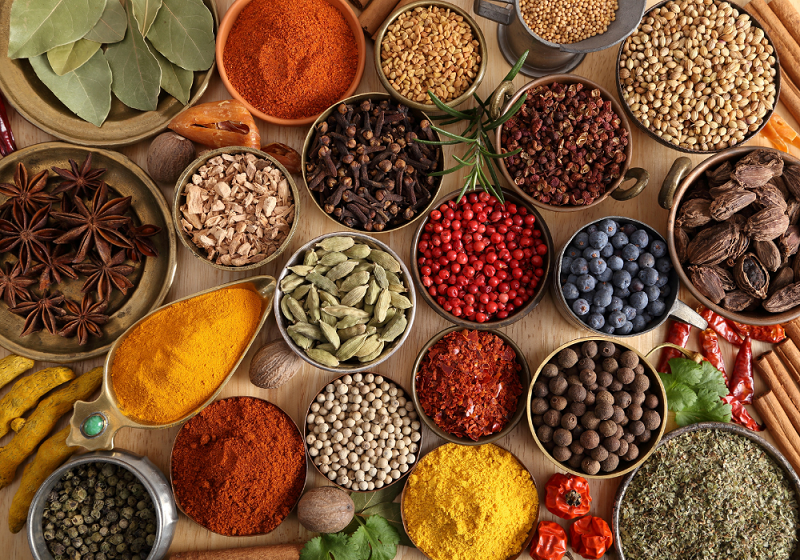The turmeric, This famous golden spice holds a very important place in our kitchens thanks to the vibrant color it brings to our dishes and its exceptionally warm flavor. Providing many health benefits, turmeric can be consumed in various forms (spices, dried slice, fresh root), and it can be used in different ways in cooking. It is widely used in Southeast Asian countries, as well as in many other regions of Asia. In Indian cuisine, turmeric is revered for its ability to enhance the flavors of other spices, create a harmonious balance in dishes, and contribute to the overall richness and complexity of flavors that make Indian cuisine so unique and appreciated worldwide.
However, you may find yourself running out of turmeric in your kitchen, or you might have a guest who is sensitive to this spice, or you may simply want to diversify your spices for an explosion of flavors. What can you use to replace turmeric? What are the possible alternatives for this spice? This is what we will explore in this article, highlighting the unique flavors and culinary uses of each alternative. These different turmeric substitutes will offer you a variety of options that will brighten up your dishes and stimulate your creativity in the kitchen.
Why replace your use of Turmeric ?
We all agree that turmeric adds a unique taste to our recipes with its complex flavor. It plays an important role in Ayurvedic medicine, where it is valued for its anti-inflammatory and antioxidant properties, contributing to joint health. However, some people might want to replace it for various reasons such as:
Food allergies or intolerances : Some people may be allergic to curcumin, which is the active ingredient in this spice. It could cause them adverse reactions such as stomach aches, nausea, or abdominal pain. Therefore, it is essential for these individuals who are intolerant to turmeric to find safe alternatives.
Variety and creativity in cooking Finding an alternative to turmeric might sometimes simply mean looking to diversify meals and experiment with new flavors. Some people enjoy discovering new tastes, so getting a bit creative and trying out new spices in dishes that contain turmeric might lead you to experience new flavors.
Health benefits Our body needs different minerals and vitamins, and each spice contains these essential nutrients in varying amounts along with its therapeutic properties. Therefore, it would be beneficial to take advantage of the specific benefits of another spice while diversifying your diet with an interesting alternative.
Unavailability of turmeric Let's imagine that you are going to have guests over at your place, and you are planning to prepare a dish with turmeric as the main ingredient, but you realize at the last minute that you don't have it on hand! What is the easiest solution in this case? Finding a substitute for turmeric in your kitchen is simpler and faster than going to buy it at the grocery store, and moreover, it won't make you lose time in preparing your dish.
Economy Turmeric can sometimes be expensive, especially if it is an imported spice. Finding a cheaper alternative can be economically advantageous.
Personal taste In the end, some people do not like the strong taste of this spice because it remains a matter of personal preference. You might prefer the taste of another spice over turmeric in certain recipes.
Can curry replace turmeric ?
When talking about curry and turmeric, some people often get confused because they believe it's the same spice, but in reality, it's not! Turmeric is a spice that comes from the rhizome of the plant of the same name and has an earthy taste, while curry is a blend of spices with turmeric as the main ingredient, which gives it its yellow color. The other spices in curry include cumin, coriander, ginger, black pepper, and other spices. It's important to know that the taste of curry varies from one curry to another because the recipe can change depending on who prepared the blend, but its flavor remains stronger than that of turmeric. Some curries can be spicy because they contain chili peppers, which can give your dish a very spicy flavor, while others are not necessarily spicy.
So, replacing turmeric with curry powder could completely change the taste of your dish compared to using turmeric alone, as on its own it provides a milder and more fragrant flavor. However, when mixed with other spices in curry, it could be stronger or even spicier in your dish, which might not be to everyone's liking. This brings us to say that the decision is up to you based on your desires and personal preferences.
What is the spice whose color most closely resembles turmeric ?
The spice whose color most closely resembles turmeric is saffron. Turmeric has a yellow color, while saffron has an intense golden yellow or yellow-orange color. Some believe that curry is the spice whose color most closely resembles turmeric, but this is not really the right choice because the color of curry can vary from yellow to brown, depending on the spices used, and it actually comes from turmeric.
Saffron is a precious spice extracted from the stigmas of the flower of the crocus. Crocus sativus. This spice, originating from the Mediterranean region, is famous for its beautiful color that can be distinguished from other spices but is at the same time similar to that of turmeric. It is widely used in cooking for its special aroma and unique taste, and it can provide an incomparable flavor to create delicious meals. It is particularly recognized in rice dishes (paella), risottos, and broths. It can be considered an excellent alternative to turmeric but with a more complex and powerful taste, thus adding an extra touch of color to your dishes.
The only drawback of using this coloring spice is its price; it is one of the most expensive spices in the world due to the manual harvesting process of the stigmas. Therefore, daily use of saffron could be economically disadvantageous.
9 alternatives to using turmeric
Here are 9 alternatives to using turmeric in your recipes, but don't forget that the choice of the spice that best suits your dish will depend on your taste preferences and the effect you wish to achieve in terms of color and flavor.
- Ground ginger: "The" ginger can be an excellent option to replace turmeric. Belonging to the Zingiberaceae family, ginger offers a spicy and pungent flavor, so be careful with the amount you use if you don't like overly spicy dishes. It adds a pale yellow tint to your dishes.
- Saffron: The color of the spice most similar to turmeric is saffron. As we mentioned earlier, this spice is more expensive, so using it every day would not be a great idea.
- Mustard powder: Mustard powder (or yellow mustard seed or dry mustard) doesn't really have a flavor equivalent to turmeric, but it is interesting if you want to add heat and flavor to your dishes because this powder is slightly spicy.
- Paprika: Economically speaking, paprika is more accessible than turmeric, making it a good alternative for people looking to save money. Sweet paprika or smoked paprika can be a reasonable substitute for turmeric in certain recipes as it adds a mild and slightly smoky flavor to your dishes, especially if you are looking to add color, which in the case of paprika is red. This could transform a simple preparation into a delicious recipe.
- Cumin: It is the perfect alternative to turmeric because it has an earthy flavor with a hint of bitterness that is similar to that of turmeric. Ground cumin or cumin seeds are highly valued in certain recipes, particularly in Indian or Middle Eastern dishes.
- Curry powder: As we mentioned earlier, curry is a blend of spices with turmeric as the main ingredient, but it also includes other spices. Widely used in Asian cuisine, curry is a versatile alternative due to the mix of spices it contains and can be used to achieve a similar flavor.
- Safflower: Also known as false saffron, it does not have a taste perfectly similar to turmeric, but they share a common characteristic of coloring food. If you use safflower instead of turmeric, you will achieve the desired beautiful yellow hue in your dishes.
- Annatto seeds: Annatto seeds are often used to color dishes, giving them a reddish-orange hue and a mild flavor.
- Nutmeg: Nutmeg is a spice that, although very different from turmeric, can be considered an alternative in certain recipes. It originates from the islands of the Indian Ocean and is obtained from the kernel of the fruit of the nutmeg tree. Unlike turmeric, nutmeg offers mild, warm, and slightly sweet flavors. It is generally used in small quantities to flavor a variety of savory and sweet dishes.







